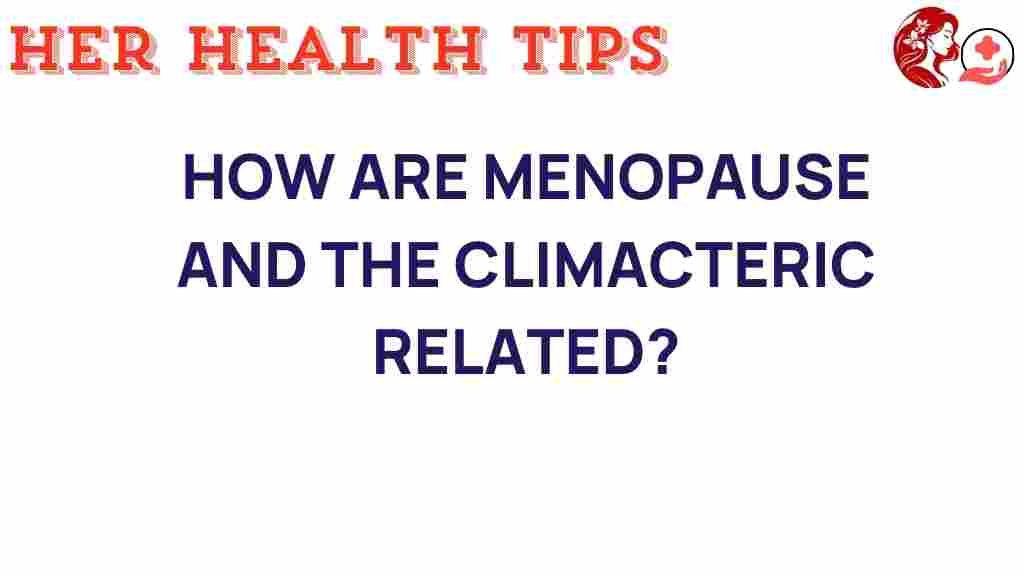Unveiling the Connection: Menopause and the Climacteric Explained
Menopause is a natural phase in a woman’s life, marking the end of her reproductive years. Often accompanied by various symptoms and hormonal changes, this transition can significantly impact women’s health and emotional well-being. Understanding menopause and the climacteric period is crucial for women to navigate this stage of life with awareness and confidence.
Understanding Menopause and the Climacteric
The term “climacteric” refers to the transitional phase leading to menopause, which typically occurs in women between the ages of 45 and 55. This period is characterized by a decline in ovarian function, resulting in hormonal changes that can cause various physical and emotional symptoms.
During the climacteric, women may experience:
- Hot flashes
- Night sweats
- Irregular menstrual cycles
- Sleep disturbances
- Mood swings
- Vaginal dryness
It’s essential to recognize that these symptoms are part of a natural aging process and not a disease. Increased health awareness about menopause can empower women to seek support and treatment options when necessary.
The Hormonal Changes During Menopause
As women approach menopause, their bodies undergo significant hormonal changes. The primary hormones involved are estrogen and progesterone, which regulate the menstrual cycle and affect various bodily functions.
Key hormonal changes include:
- Estrogen Decline: Estrogen levels fluctuate and eventually decrease, leading to many menopause symptoms.
- Progesterone Reduction: Lower progesterone levels can result in irregular periods and affect mood and sleep.
- Testosterone Levels: Though often overlooked, testosterone also plays a role in women’s health, influencing libido and energy levels.
Symptoms of Menopause
The symptoms of menopause can vary widely among women, with some experiencing mild discomfort while others may find the symptoms more disruptive to their daily lives. Common symptoms include:
- Hot Flashes: Sudden feelings of warmth, often accompanied by sweating and flushing.
- Night Sweats: Hot flashes occurring during sleep, leading to sleep disturbances.
- Mood Changes: Increased irritability, anxiety, or depression due to hormonal fluctuations.
- Weight Gain: Hormonal changes can lead to weight gain, especially around the abdomen.
- Memory Issues: Some women report forgetfulness or difficulty concentrating.
- Vaginal Changes: Thinning and drying of vaginal tissues can occur, leading to discomfort during intercourse.
The Transition Into Menopause
The transition into menopause, often referred to as perimenopause, can last several years. This phase can start as early as the mid-30s and continues until menopause is officially diagnosed after 12 consecutive months without a menstrual period.
During this transition, women may experience:
- Irregular periods
- Increased PMS symptoms
- Changes in menstrual flow
Health Awareness and Management Strategies
Awareness and education about menopause are vital for women’s health. Here are some strategies to manage symptoms effectively:
1. Lifestyle Changes
- Diet: A balanced diet rich in fruits, vegetables, whole grains, and lean proteins can help manage weight and improve overall health.
- Exercise: Regular physical activity can alleviate symptoms, improve mood, and enhance bone health.
- Hydration: Staying hydrated can help reduce hot flashes and improve skin health.
2. Medical Treatments
Consulting a healthcare provider can lead to various treatment options, including:
- Hormone Replacement Therapy (HRT): This can alleviate many symptoms by replenishing estrogen and progesterone levels.
- Non-Hormonal Medications: Certain antidepressants and other medications can help with mood swings and hot flashes.
- Vaginal Lubricants: These can ease discomfort associated with vaginal dryness.
3. Emotional Well-Being
Addressing emotional well-being during menopause is equally important. Consider the following approaches:
- Support Groups: Connecting with other women experiencing similar changes can provide valuable support and advice.
- Mental Health Care: Speaking with a therapist or counselor can help manage anxiety or depression related to menopause.
- Mindfulness and Relaxation Techniques: Practices such as yoga, meditation, and deep-breathing exercises can improve emotional health.
Troubleshooting Common Concerns
Here are some common concerns women face during menopause, along with troubleshooting tips:
Hot Flashes
Concern: Hot flashes can be disruptive and uncomfortable.
Solution: Dress in layers, avoid triggers like spicy foods, and consider relaxation techniques.
Sleep Disturbances
Concern: Many women experience insomnia or disrupted sleep patterns.
Solution: Establish a calming bedtime routine, limit caffeine intake, and create a comfortable sleep environment.
Mood Swings
Concern: Mood swings can affect daily life and relationships.
Solution: Regular exercise, balanced nutrition, and seeking therapy can help stabilize mood.
Conclusion: Embracing the Transition
Menopause and the climacteric are significant life transitions for women, often accompanied by various health challenges. However, with increased health awareness, women can take proactive steps to manage symptoms and enhance their emotional well-being. Understanding the hormonal changes during menopause, recognizing symptoms, and exploring lifestyle changes and medical treatments can empower women to navigate this phase confidently.
As we embrace the natural aging process, it’s important to remember that menopause is not an end but a new beginning. By fostering open discussions about menopause and seeking support, women can transform this journey into an opportunity for growth and self-discovery.
For more detailed information on women’s health and menopause, consider visiting this resource, and always consult with a healthcare provider to tailor the best approach for you.
This article is in the category Reproductive and created by HerHealthTips Team
